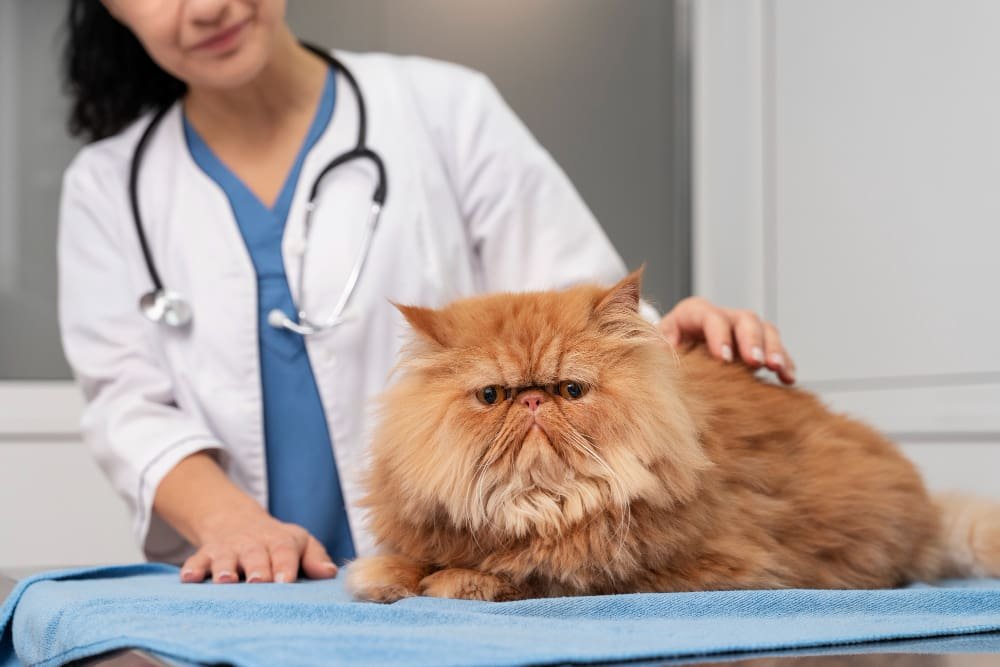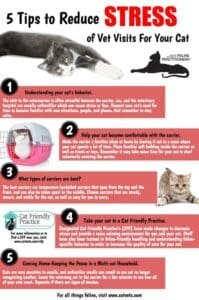Train your cat to embrace vet visits without fear or anxiety. By focusing on effective training techniques, you can transform the once stressful experience into a calm and positive one. Imagine a world where you can easily train your cat to hop into their carrier, ready for a peaceful journey to the veterinarian. In this article, we will explore a range of proven strategies to help you train your cat specifically for vet visits.
From gradual desensitization to positive reinforcement, these methods will empower you to create a more relaxed and confident feline companion. Training your cat for veterinary appointments not only benefits their emotional well-being but also strengthens the bond between you and your furry friend. Say goodbye to the days of stressful struggles and embrace a new era of tranquil trips to the vet. With patience, consistency, and the right approach to train your cat, you can make a world of difference in their life and ensure that they receive the medical care they need without unnecessary fear or anxiety. So, let’s embark on this transformative journey together and discover how you can successfully train your cat to make vet visits a breeze!
Why Training Cats for Vet Visits is Important
Understanding the risks of untrained cats
When cats are not properly trained for vet visits, it can lead to various risks and challenges. Untrained cats may become stressed and anxious in unfamiliar environments, which can make it difficult for veterinarians to examine them and administer necessary treatments. This can result in missed or delayed diagnoses, which can ultimately impact the health and well-being of your cat. Additionally, untrained cats may exhibit aggressive behavior, making it unsafe for both veterinary staff and the cat itself. By training your cat for vet visits, you can help reduce these risks and ensure a smoother and less stressful experience for everyone involved.
Benefits of training cats for vet visits
Training your cat for vet visits comes with a multitude of benefits. Firstly, it helps to reduce stress and fear in cats, making the entire experience more positive. A trained cat will be more cooperative during examinations, allowing the veterinarian to perform a thorough assessment and provide appropriate care. Moreover, training your cat for vet visits fosters a sense of trust and confidence between you and your feline companion. It also helps to establish a positive relationship with your veterinarian, leading to better communication and a higher quality of care for your cat. Ultimately, training your cat for vet visits not only benefits their physical health but also their emotional well-being.
Understanding Cat Behavior
Instinctual behavior of cats
To effectively train your cat for vet visits, it is crucial to understand their instinctual behavior. Cats are naturally independent animals with a strong sense of self-preservation. They may perceive vet visits as a threat to their territory and autonomy, leading to fear and stress. Recognizing and respecting these instincts will help you tailor your training approach to your cat’s individual needs.
Understanding fear and stress triggers
Fear and stress triggers can vary among cats, but there are some common stimuli that often cause anxiety during vet visits. These may include the sight and smell of other animals, the presence of unfamiliar people, loud and unfamiliar noises, and the sensation of being confined in a carrier. By identifying and understanding these triggers, you can better prepare your cat and implement appropriate training techniques to alleviate their fears.
Body language signals to watch for
Cats communicate their emotions through body language, and being able to recognize these signals is essential during vet visits. Some common signs of stress or fear in cats include flattened ears, dilated pupils, tense body posture, tail flicking, hissing, growling, and attempts to hide or escape. By observing and responding to these signals, you can help your cat feel more secure and minimize their anxiety during vet visits.
Preparing Your Cat for Vet Visits
Selecting the right veterinarian
Choosing the right veterinarian is a crucial step in preparing your cat for vet visits. Look for a veterinarian who is experienced and knowledgeable in handling feline patients, as they will understand the unique needs and behavior of cats. It is also beneficial to schedule a meet-and-greet appointment with the veterinarian so that your cat can become familiar with their presence and scent in a non-threatening environment.
Choosing a carrier and acclimating your cat
The choice of a carrier plays a significant role in preparing your cat for vet visits. Opt for a carrier that is secure, well-ventilated, and easy to clean. To help your cat acclimate to the carrier, make it a positive and comfortable space by laying a soft blanket or bedding inside. Leave the carrier open in your home and encourage your cat to explore it at their own pace. By making the carrier a familiar and safe place, your cat will be less stressed when it comes time to use it for vet visits.
Handling techniques to desensitize your cat
Desensitization plays a key role in training cats for vet visits. Start by gradually introducing your cat to gentle handling exercises, such as touching their paws, ears, and tail. Reward your cat with treats and praise for displaying calm and relaxed behavior during these sessions. By gradually increasing the duration and intensity of handling, your cat will become more comfortable and less resistant to being handled during vet visits.
Positive Reinforcement Training Methods
Creating positive associations with vet visits
Positive associations are essential in training cats for vet visits. Start by associating the veterinary clinic with pleasant experiences, such as giving treats or playing with toys. Allow your cat to explore the waiting area and examination rooms at their own pace, rewarding them for calm behavior. By pairing the vet visit with positive experiences, your cat will begin to associate it with something enjoyable, which can help alleviate their fears and anxieties.
Using treats and toys as rewards
Treats and toys can be valuable tools in training cats for vet visits. Use high-value treats that your cat finds particularly enticing, and reward them for desirable behaviors during the training process. Additionally, interactive toys can help distract and engage your cat during waiting periods at the vet clinic, further reducing their stress and anxiety.
Clicker training techniques
Clicker training, a form of positive reinforcement training, can be an effective technique for training cats for vet visits. By pairing the sound of a clicker with treats or rewards, you can communicate to your cat that they have performed a desired behavior correctly. This form of training helps to reinforce positive behavior and can be particularly useful for tasks such as crate training or teaching your cat to tolerate handling during veterinary exams.
Desensitization and Counterconditioning
Gradual exposure to vet-related stimuli
Gradual exposure to vet-related stimuli is crucial in desensitizing your cat. Begin by introducing your cat to each component of a vet visit separately, such as the carrier, examination table, and handling tools. Pair each exposure with positive reinforcement, rewarding your cat for remaining calm and relaxed. Gradually increase the difficulty and duration of these exposures over time, until your cat becomes comfortable with each step of the vet visit process.
Replacing negative experiences with positive ones
If your cat has had negative experiences during previous vet visits, it is important to replace those memories with positive ones. Focus on creating new, positive associations with the veterinary clinic through training exercises and rewards. By consistently providing positive experiences, you can help your cat overcome any previous negative associations and build a more positive outlook on vet visits.
Using pheromone sprays or diffusers
Pheromone sprays or diffusers, such as those containing synthetic feline facial pheromones, can help create a calm and familiar environment for your cat during vet visits. These products mimic the natural pheromones that cats release when they feel safe and secure, helping to reduce anxiety and promote relaxation. Consider using these pheromone products in your home and in the carrier leading up to and during vet visits to create a soothing atmosphere for your cat.
Introducing Handling and Examination
Teaching your cat to tolerate handling
Teaching your cat to tolerate handling is an essential aspect of training for vet visits. Start by gently touching different parts of your cat’s body, such as their paws, ears, and belly, rewarding them with treats and praise for remaining calm. Gradually increase the duration and intensity of handling, ensuring your cat feels comfortable and secure throughout the process. This will help prepare your cat for the various handling procedures they may encounter during veterinary examinations.
Practicing mock examinations at home
Practicing mock examinations at home can help familiarize your cat with the routine procedures they may encounter at the vet clinic. Use gentle pressure to mimic the touch of a veterinarian during a physical examination. Reward your cat for cooperating and remaining calm throughout the process. This practice will help your cat become more comfortable with the sensations and procedures they may experience during a real vet visit.
Gradually introducing veterinary equipment
Introduce your cat to veterinary equipment gradually to minimize anxiety and fear. Start by presenting them with the sight and scent of common tools, such as a stethoscope or syringe. Reward your cat for remaining calm and relaxed in the presence of these objects. Gradually progress to touching or gently using the equipment on your cat, continuing to provide positive reinforcement for their cooperation. By familiarizing your cat with the sounds, smells, and sensations of veterinary equipment, you can help reduce their stress and fear during vet visits.
Reducing Stress During Travel
Choosing a comfortable carrier
Choosing a comfortable carrier is essential for reducing stress during travel to the vet clinic. Opt for a carrier that is spacious enough for your cat to move and turn around comfortably. Ensure the carrier is well-ventilated, secure, and stable. Consider lining the carrier with familiar bedding or clothing that carries your scent, which provides comfort and reassurance to your cat during travel.
Creating a soothing environment
Creating a soothing environment within the carrier can help reduce stress during travel. Provide soft bedding and a familiar blanket inside the carrier for added comfort. Placing a towel or blanket over the carrier can create a cozy and enclosed space that helps your cat feel more secure. Additionally, using calming pheromone sprays or diffusers in the carrier can further promote relaxation during travel.
Using calming aids or sedatives as a last resort
In some cases, despite training and preparation, cats may still experience excessive stress and anxiety during travel. As a last resort, consult with your veterinarian regarding the use of calming aids or sedatives. These medications should only be used under the guidance of a professional and in accordance with appropriate dosages. It is important to exhaust all other training and management strategies before considering the use of sedatives, as they may have potential side effects.
Tips for Successful Vet Visits
Scheduling appointments strategically
Scheduling your cat’s vet appointments strategically can help reduce stress and ensure a smoother experience. Aim for quieter times at the clinic when there is less activity and fewer animals present. This can help minimize your cat’s exposure to potential stressors and lead to a more relaxed and efficient visit.
Providing familiar objects in the waiting area
Bringing familiar objects from home into the waiting area can help provide comfort and security to your cat. Consider bringing their favorite blanket, toy, or bedding to help create a sense of familiarity and calm. Having these items nearby can help distract and soothe your cat during the waiting period.
Communicating with the veterinary staff
Open and clear communication with the veterinary staff is crucial for successful vet visits. Inform them of any specific triggers or concerns your cat may have, as well as any training techniques you have implemented. The veterinary staff can then tailor their approach and provide appropriate accommodations to ensure the best possible experience for your cat.
Addressing Common Challenges
Dealing with aggressive or fearful cats
Aggression or fear in cats during vet visits can pose challenges, but there are strategies to address these behaviors. Firstly, it is important to consult with a professional behaviorist or veterinarian who specializes in feline behavior to develop a tailored training plan. They can guide you through techniques such as desensitization, counterconditioning, and behavior modification exercises to help your cat overcome their aggression or fear.
Handling cats with a history of trauma
Cats with a history of trauma may require extra care and consideration during vet visits. Patience and understanding are key when working with these cats. Gradually introduce handling exercises, using gentle and slow movements to build their trust and confidence. It may be necessary to consult with a veterinary behaviorist or a cat behavior specialist to develop a customized plan that addresses the specific needs of your cat.
Seeking professional help if needed
If you find yourself struggling to train your cat for vet visits or if your cat’s fear or aggression persists despite your efforts, do not hesitate to seek professional help. Professional behaviorists or veterinarians with expertise in feline behavior can provide guidance and develop a customized training plan to address your cat’s specific challenges. They can also assist in determining any underlying medical issues that may be contributing to your cat’s behavior.
Maintaining Training Consistency
Regular reinforcement of training exercises
Consistency is key when training cats for vet visits. Regularly reinforce training exercises with your cat to ensure their skills and behaviors stay sharp. Practice handling, mock examinations, and carrier desensitization regularly, rewarding your cat for calm and cooperative behavior. By maintaining a consistent training routine, you can help solidify their skills and keep them prepared for future vet visits.
Ongoing practice sessions at home
In addition to regular reinforcement, ongoing practice sessions at home are essential to maintain your cat’s training progress. Dedicate time each week to go through training exercises, focusing on areas that may require additional work. By consistently practicing at home, you can reinforce your cat’s positive behaviors and foster a continued sense of calm and cooperation during vet visits.
Monitoring progress and adapting techniques
Monitor your cat’s progress throughout the training process and be prepared to adapt your techniques as needed. Each cat is unique and may require different approaches to training. Observe your cat’s reactions and responses during training exercises and make adjustments accordingly. By continuously monitoring and adapting your techniques, you can ensure that your cat receives the most effective training and support for vet visits.
By following these guidelines and investing time and effort into training your cat for vet visits, you can significantly reduce stress and fear, creating a more positive experience for both your cat and the veterinary staff. Remember, training is an ongoing process, and with patience, consistency, and positive reinforcement, you can help your cat become a confident and cooperative patient during vet visits.


